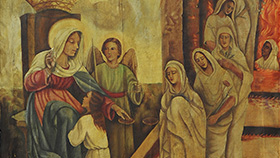
On walking around the impressive church of Peraleda, we are soon drawn by a large painting somehow causing awe and fascinating horror. Just a little bit of Christian lore is enough to realize that what you are contemplating is a shocking heretic scene. We can see the Last Judgment, but it is not Jesus, the king-judge, who judges the souls sitting on his throne, but Mary. ¿Mary the judge? Nothing like this is found in the history of Christian art. But this is just the beginning. Let’s analyse this painting in detail so that we can sip in its every strange detail.
1- PSYCHOSTASIA
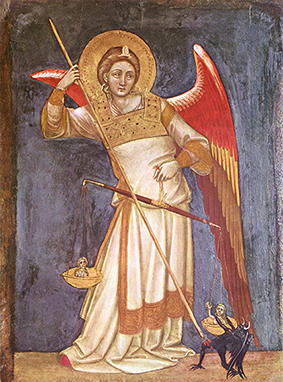
Psychostasia is a Greek word meaning “the weighing of souls”. It is a traditional theme in Christian art, deriving from older Greek and Egyptian traditions. The Christianised version shows St. Michael the Archangel winged, often clad in armour or a white robe. He is holding a scale where the souls are weighed. On each plate there is a little naked figure, a human soul (sometimes represented as a heart). You may have a demon trying in vain to tilt the scales towards his side, being neutralized by the archangel, who is holding a sword or a spear for that purpose. This scene is merely a metaphor, a symbol of the Last Judgment.
2- THE LAST JUDGEMENT
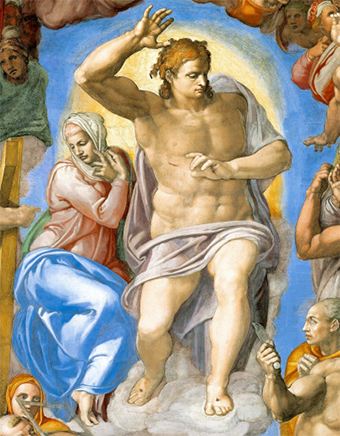
More purely Christian is a representation of the Last Judgement based on the scatological descriptions found in the Bible. Here we see Jesus as a judge, often sitting on a throne, judging the dead who rise from their graves and go up to Him. Some are sent up to heaven and others to hell, represented as a cave breathing out flames. In this case we can often find Mary kneeling by His side interceding for the salvation of the souls.
3- THE SOULS IN PURGATORY
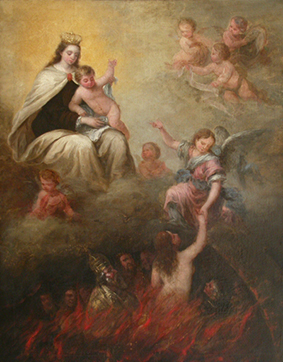
A third artistic theme connected to the Last Judgement is that of the purgatory. The souls of the saved who are still stained by non-mortal sins need a purification process before entering heaven. When St. Paul or Zechariah talk about this purification process, they use the metaphor of fire, which has inspired Catholic art to represent purgatory as the place where the souls (depicted as naked people) cry out for help from among the cleansing, but not harmless, flames asking for our intercession and for Mary’s, so they can speed up the process and go to heaven. In this scene the flames of purgatory are always at the bottom of the picture, and Mary is floating above.
OUR PAINTING OF THE “ANIMAS” OR SOULS
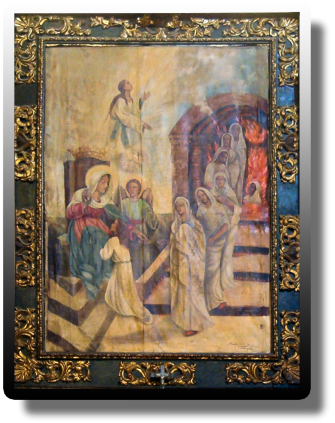 On watching this painting carefully, our first impression is, as we said, to be before a heretic representation of the Last Judgement, where Mary is sitting on the throne weighing the souls and deciding salvation or damnation in the stead of Jesus. Nevertheless, if you look again we can see that things are actually quite different. No heresy but lots of originality.
On watching this painting carefully, our first impression is, as we said, to be before a heretic representation of the Last Judgement, where Mary is sitting on the throne weighing the souls and deciding salvation or damnation in the stead of Jesus. Nevertheless, if you look again we can see that things are actually quite different. No heresy but lots of originality.
First we must understand that this precious painting is mixing in a very peculiar way all three topics we mentioned before: Psychostasia (or the weighing of souls), the Last Judgement and Purgatory. The resulting scene is shocking, but if we analyse its parts we find it all to be sound Catholic theology.
So we find the psychostasia here, and as usual, it is St Michael who, in behalf of God, holds the scales with one hand and a sword on the other. We mentioned before that in these cases we may find a demon trying to tilt the scales on his favour so as to take the unfortunate soul away. Well, what we find here in our painting is not a demon, but Mary herself pressing her hand on the plate so as to outweigh the soul’s sins and thus liberate it. The soul is not represented as a little figure on the plate, as it is the usual thing to do, but life-sized kneeling before Mary asking for her intersection, while St Michael looks at Mary wating for the result in expectation.
Mary is holding a little something on her right hand (¿the heart of the deceased person?). If in traditional representations the trick of the devil is futile, here the action of Mary leaning the scales in favour of the penitent is efficacious. We can see that because after the ceremony the soul ascends to heaven (left hand side of the painting). So what we can see in this painting in the most original way (since nothing of the sort can be seen in Christian art), is a representation of the Catholic role of Mary as intercessor, not judge.
In fact, this is not a representation of the Last Judgement, although it is connected to it. The scene of the psychostasia is used in representation of or as part of the Last Judgement, but here we find it in a different context, as part of the purification process of purgatory. The souls, in the shape of men and women clad in white robes, are coming out of a place in flames. This place is not hell (you can’t escape hell), but purgatory, so they are souls who have already been judged and declared saved, though still in need of full purification before entering heaven, since according to the Book of Revelation 21:27 “Nothing impure will ever enter it”.
Every soul is holding an instrument of the Passion (cross, whip, spear, stick with sponge and nails), as a symbol of Jesus’ death, which saved them, or maybe to show that their suffering is reflecting that of Jesus. They are all dressed in white robes (a symbol of purity according to the book of Revelation) to emphasize that they are the souls of the righteous. The only difference here is that they are covering their heads with a veil (that makes them look like women, but some of them actually have male features), like those who prefer to hide in shame. When they are liberated from all their sins (such as the ascending soul on the left or the other one kneeling before Mary), then the covering coat disappears and they are dressed just in their purity garment. A blue sash, which is usually used as an attribute of Mary, signifies their “ticket to heaven” thanks to her, as we can see in that soul which, free from the weight of her sins, is going up to heaven.
The soul floating upwards to heaven and that one kneeling before Mary is very probably the same person depicted in two consecutive phases. According to this, we can read the story of this painting like this: 1- A group of people from purgatory come to Mary for help; 2- One of them is already kneeling down asking for her intercession; 3- Mary intercedes for her (by metaphorically placing her hand on the plate of St Michael’s scales); 4- The purified soul ascends to heaven while the rest are waiting for their turn.
So this very peculiar psychostasia is taking place AFTER the Last Judgement, not in its stead. In contrast to traditional iconography, it is not used as a metaphor of the Judgement, but as a metaphor of the power of intercession of Mary, who can intervene to accelerate the purification of the souls who have already been declared saved.
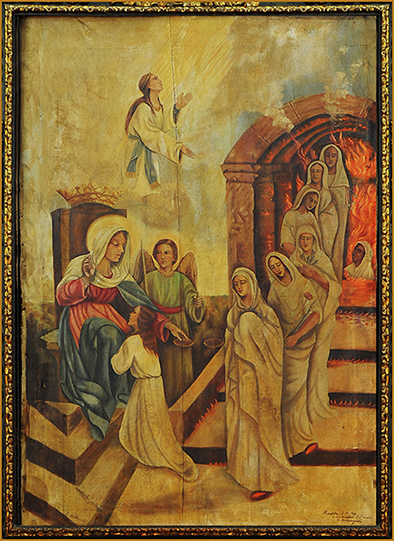
Location:
Escrito por Angel Castaño


